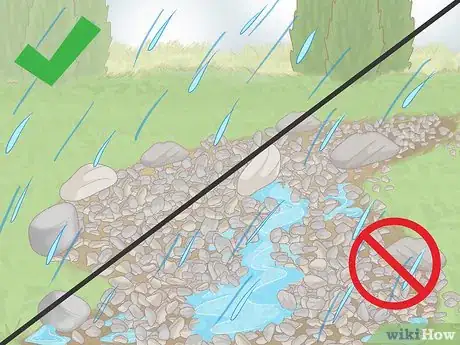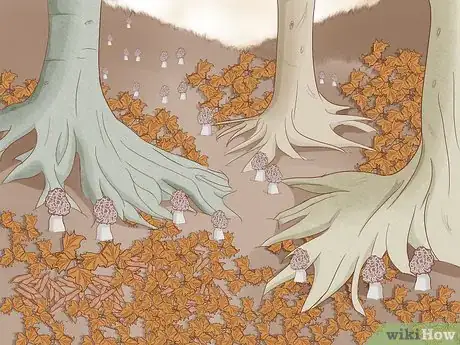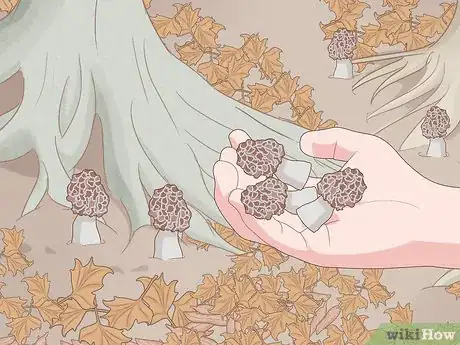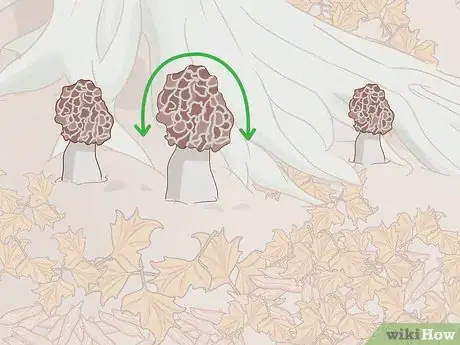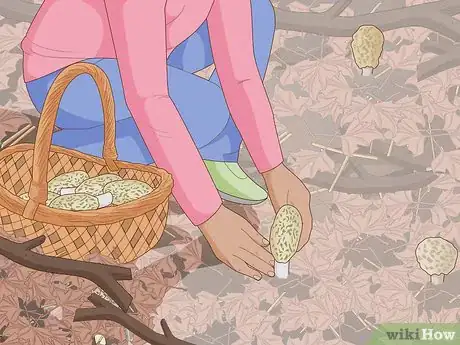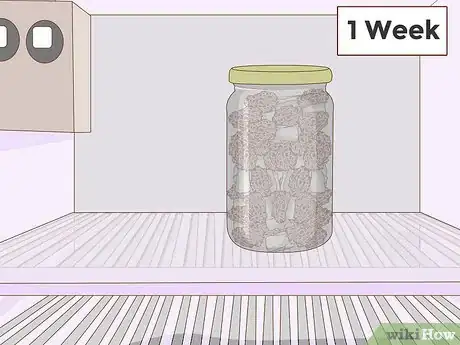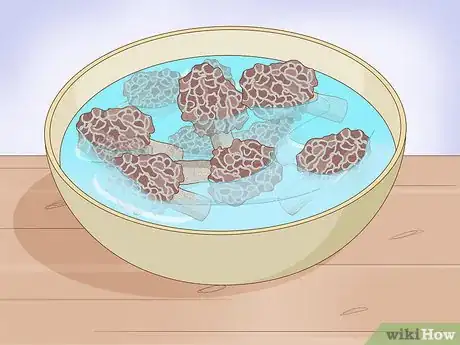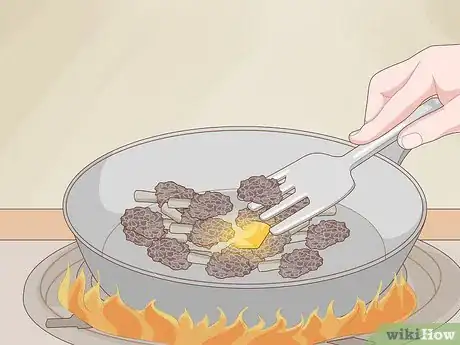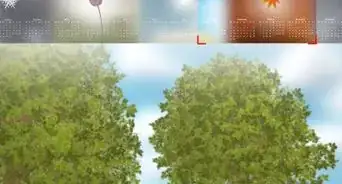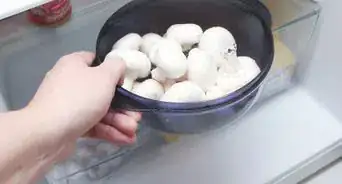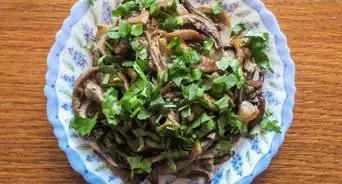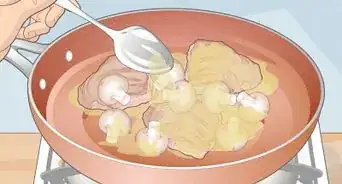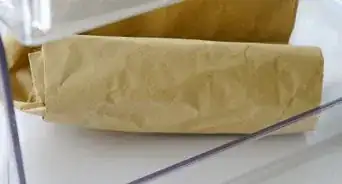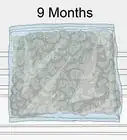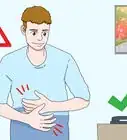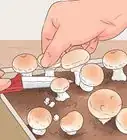This article was co-authored by Ollie George Cigliano. Ollie George Cigliano is a Private Chef, Food Educator, and Owner of Ollie George Cooks, based in Long Beach, California. With over 20 years of experience, she specializes in utilizing fresh, fun ingredients and mixing traditional and innovative cooking techniques. Ollie George holds a BA in Comparative Literature from The University of California, Berkeley, and a Nutrition and Healthy Living Certificate from eCornell University.
There are 7 references cited in this article, which can be found at the bottom of the page.
This article has been viewed 51,254 times.
Morel mushrooms are relatively easy to identify, not produced commercially, and taste absolutely delectable. They start cropping up in the spring, from late April through May. You can identify them by their honeycomb-like exterior. Look for them around trees and well-drained areas and go with an experienced hunter if you can. Once you’ve found them, cut them gently, wash them thoroughly, and saute them with butter to enjoy their delectable flavor.
Steps
Searching at the Right Time and Place
-
1Begin to search in late April and continue through May. If you’ve had about a week of warmer temperatures, when it has been rainy and consistently above 50 °F (10 °C), it’s likely that morels are beginning to appear. Morels thrive when the nighttime temperatures stay above 40 °F (4 °C).[1]
- A wet spring will quite often mean a very good mushroom season.
-
2Concentrate on southward and westward slopes early in the season. These areas will be the first to warm up and promote mushroom growth when the outdoor temperatures start to rise. Look on grassy slopes and forests. As the season goes on, you can expand your search to all slopes.[2]
- The humidity of a forest is very likely to encourage morel growth.
Advertisement -
3Search areas that receive rainfall but don’t hold onto it. A well-drained creek bed is an ideal place for morels to grow. Check sloped areas that get a lot of rain as well.[3]
- Places where a lot of rainwater sits on the surface, like a swamp or trickling stream, are generally not ideal environments for morels to grow.
-
4Look around dead or dying trees. Morels often grow along the root systems of certain species of trees. Search around elm, sycamore, hickory, and ash trees first. Then, check fruit trees. Look especially for dying trees with bark slipping off their trunks.[4]
- An elm tree that has just died in the last few years is one of the surest bets.
- An old apple orchard is often a good place to find morels.
-
5Create a search pattern when you have found one morel. After you find your first morel, slow down your search. Comb over the whole area very carefully. Concentrate the rest of your search that day on similar areas.[5]
- For example, if you found a morel in a creek bed, keep searching the rest of the creek or other dried creeks nearby.
Identifying Morels
-
1Look for the morel’s typical honeycomb-like cap. Identify a morel by its intricate pattern of folds that look like a honeycomb. The inside of the cap is white-ish. The true morel has the bottom of the cap attached near the bottom of the stem.[6]
- A half-free morel has a longer stem and the cap attaches near the cap, resembling an umbrella. While this type of morel is not poisonous, it can cause cramps or other gastrointestinal distress for some people.
-
2Keep an eye out for morels of various sizes and shapes. Morels vary in shape from oblong to bulbous, and their color can be anything from blonde to grey. They also come in various sizes, from as small as your fingertip to even bigger than your hand.
- Look for the smaller grey morel early in the season, and the bigger yellow morel later in the season.
-
3Avoid the false morel. The distinctive features of the morel mushroom make it very hard to confuse with other potentially toxic varieties. However, the false morel does grow in the same areas as real morels, and they look similar. You can recognize a false morel because its cap has shallow wrinkles and not the deep, hollow pits of the real morel.[7]
- The false morel contains the chemical monomethyl hydrazine (MMH), which can cause vomiting, dizziness, diarrhea, and sometimes even death.
- If in doubt, try slicing open the mushroom. A real morel will be hollow inside. A fake morel will have wispy fibers or chunks of tissue inside.
-
4Hunt with someone experienced. A seasoned mushroom hunter can help you correctly identify the real morel mushrooms and avoid toxic varieties. They can also show you typical places to search and how to make a search pattern once you’ve discovered some morels so you’ll have more success in your hunt.[8]
- If you don’t know any mushroom hunters, look for a local class or club you can join.
- You can also take an illustrated field guide with you when you go hunting to help you search for an identify mushrooms.
- Eating toxic mushrooms can make you very sick and in some cases may be life-threatening. Seek emergency medical care if you start to experience any negative symptoms after eating a mushroom.
Harvesting and Preparing
-
1Cut the morel with 1 inch (2.5 cm) or less of the stem. Use a sharp knife to slice the stem of the morel. The stem of the morel mushroom is edible. However, leaving some stem in the ground will promote more morel growth in the future.
- It’s best not to pluck them out of the ground because they will come out of the soil dirty and frayed.
-
2Place the harvested morels in baskets with holes to let them breathe. Don’t squish the mushrooms. Simply pile them gently into a breathable basket or other container. Cover the container with a cloth so no debris gets in.
- Mushrooms need access to oxygen just like people. Otherwise, bacteria will build up in the mushroom and it will begin to decay.
-
3Keep your morels for about 1 week in the refrigerator. Stack them only a few layers deep in a dish or other container. Make sure they have plenty of space for air to circulate around them to keep them fresh.
- You can also dry your morels to help them last from 6 months to 1 year.
- Watch for worms in the mushrooms. Remove any mushrooms with worms as soon as you spot them to keep them from contaminating any more of the batch.
-
4Soak the mushrooms in water for a couple of minutes just before eating. Fill a large bowl with cold water. Add about 2 tablespoons (17 g) of salt to the water. Place the morel mushrooms you want to consume into the water. Let them soak for 5-10 minutes. Then, fish out the mushrooms with a big spoon and rinse them under cold water in a colander for 1-2 minutes. Place them on a paper towel or clean dish towel to dry.[9]
- Try slicing the mushrooms in half before you soak them for a more thorough cleaning.
- You may want to shake the bowl after you put the mushrooms. Swish them around by gently cupping them in your hand and swirling around in the water to dislodge any dirt or insects inside the folds of the caps.
- Transfer clean mushrooms to a clean dry cloth to drain. Only begin preparation when the mushroom is completely dry.
-
5Saute the morels in butter to bring out the best of their flavor. Most people don’t like to make any fancy dishes with their morels because they taste so good simply sauteed. To do this, slice the morels in half lengthwise. Melt butter in a saucepan over low heat and add the mushrooms. Saute for 3-5 minutes until they turn golden brown.
- If you want to experiment with your morels, try putting them in scrambled eggs with some tarragon, or fry them in a batter.
- It’s not recommended to eat morels raw. They don’t taste very good this way, and they can cause stomach cramps or gastrointestinal distress.
Things You'll Need
- Sharp knife
- Basket for collecting
- Clean cloth
- Kitchen knife
- Large bowl
- Saucepan
Warnings
- Observe local laws when you go out mushroom hunting. Don’t hunt on private property unless you have permission. Check local laws online in your area. Some public land may be off-limits as well.⧼thumbs_response⧽
- If you have any doubt about a mushroom, don’t keep it.⧼thumbs_response⧽
- It’s best to never go mushroom picking alone. Bring water, snacks, a lighter, a first aid kit, bug spray, and bear spray. You should also have a GPS and a satellite phone if you are in a very remote area.[10]⧼thumbs_response⧽
References
- ↑ https://www.outdoorlife.com/articles/survival/2016/04/12-tips-finding-more-morel-mushrooms-spring
- ↑ https://www.outdoorlife.com/articles/survival/2016/04/12-tips-finding-more-morel-mushrooms-spring
- ↑ https://www.outdoorlife.com/articles/survival/2016/04/12-tips-finding-more-morel-mushrooms-spring
- ↑ https://www.fieldandstream.com/articles/hunting/2013/04/finding-cooking-morel-mushrooms#page-9
- ↑ https://www.fieldandstream.com/articles/hunting/2013/04/finding-cooking-morel-mushrooms#page-6
- ↑ https://www.fieldandstream.com/articles/hunting/2013/04/finding-cooking-morel-mushrooms#page-2
- ↑ https://www.outdoorlife.com/articles/survival/2016/04/12-tips-finding-more-morel-mushrooms-spring#page-2
- ↑ https://www.outdoorlife.com/articles/survival/2016/04/12-tips-finding-more-morel-mushrooms-spring#page-2
- ↑ https://www.fieldandstream.com/articles/hunting/2013/04/finding-cooking-morel-mushrooms#page-11
About This Article
To find morel mushrooms, check southward and westward slopes in late spring, since they tend to appear there first. Next, search areas that fill up with rainwater but drain quickly, like dry creek beds and trickling streams. Be sure to take a close look around dead or dying trees, since morels often grow along their root systems. Morels are usually white and have honeycomb-like caps, but you may want to take an experienced mushroom hunter with you to avoid any mishaps. For more tips on identifying morels, read on!


